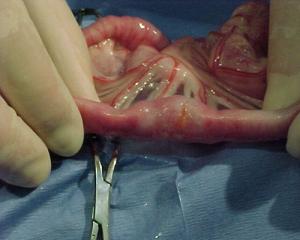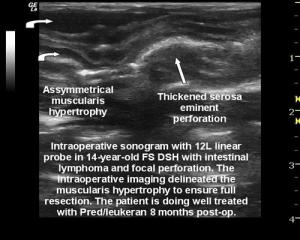Clinical Differential Diagnosis
Hyperthyroidism, IBD, neoplasia, pancreatitis, tricobezoar.
Sonographic Differential Diagnosis
Intestinal lymphoma, mast cell disease,IBD, FIP, carcinoma less likely.
Sampling
Laparotomy was performed with intraoperative imaging of the intestinal tract in order to isolate the small intestinal thickening of the muscularis. A focal region of intestinal perforation was present without significant serosal changes and minor surgically palpable thickening of the segment in question. The surgeon resected of the portion of the bowel that contained thickened muscularis according to the intraoperative sonographer's direction. Full thickness biopsy of the small intestine with normal muscularis thickness was also obtained as well as mesenteric lymph node and liver. Samples were placed in separate biopsy jars and labeled accordingly as to the sonographic presentation. Histopath: Intestine with muscularis thickening: First read was interpreted as intramural lymphocytic enteritis with muscularis hypertrophy. Second opinion interpretation: Low grade, diffuse, mucosal intestinal lymphoma with muscularis hypertrophy and mild multifocal submucosal and muscularis lymphoid infiltrate. Lymph node: low grade mast cell neoplasia. Liver: Moderate chronic lymphocytic hepatitis.







Comments